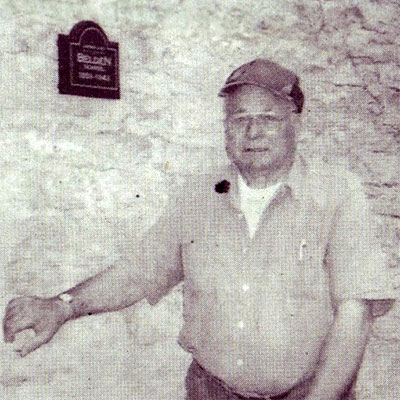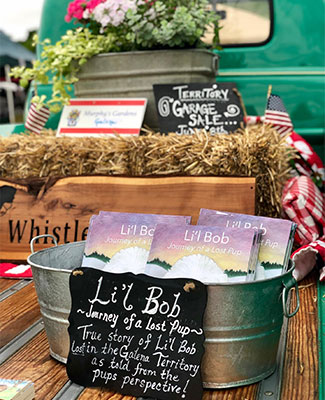
Determining where – or, more specifically, when – a story begins is a difficult task when attempting to examine a real or fictional life.
Authors or writers of any kind ponder so many possible entry points if they want to truly hook their readers.
Should they lead with the birth of their subjects? Key childhood experiences? First jobs after college? The funniest anecdote? The saddest? The most recent accolades or events?
Maybe they should open with that one moment many years ago that somehow triggered a new direction along an unexpected path – and that is exactly where this tale about writing begins.
P.J. HarteNaus was beginning her third decade of teaching social studies and literacy to elementary students in Glen Ellyn School District 41 when she enrolled in an NIU College of Education master’s degree program in 2004.
“I recall about 30 teachers from District 41 in Glen Ellyn took part in NIU’s master class, where different professors met us at different schools on our campus. It was perfect for us since we taught all day and didn’t need to travel to DeKalb. We were a tight group of educators, enjoying the NIU 18-month program.”
HarteNaus appreciated the flexibility of one class session each week. She also enjoyed the innovative coursework that the M.S.Ed. in Curriculum and Instruction offered, allowing adult students to be creative and discovering what could be accomplished educationally for children.
College of Education professors “allowed us to think outside the box,” HarteNaus says, but it was her final professor in 2005 who “would be the most memorable. She made us realize that the possibilities were endless.”
 “Our last assignment at NIU was to go out in the field and create something educational for children, whatever it might be. Questions flew and ideas were tossed around in class,” she says. “For myself, however, I thought of heading to Galena in the upper Midwest area, creating something of educational value for children out in a rural setting. I needed to think long and hard about what it could be, not sure of where to begin – at least not yet.”
“Our last assignment at NIU was to go out in the field and create something educational for children, whatever it might be. Questions flew and ideas were tossed around in class,” she says. “For myself, however, I thought of heading to Galena in the upper Midwest area, creating something of educational value for children out in a rural setting. I needed to think long and hard about what it could be, not sure of where to begin – at least not yet.”
What happened next would alter the course of her life, turning the local educator into the award-winning author of the acclaimed “Belden Boy,” an anti-bullying series of children’s books. One thing led to another with speaking engagements, creating Whistleslick Press, writing more children books and creating the Belden Boy Writing Camp inside the 1859 Belden School, the school she helped to save and home to the book series.
HarteNaus credits it all to that one challenge.
The “long and hard” reflection led her to the Galena Territory, where the family home was situated. Perhaps the woods of northwest Illinois held “something magical and educational for children,” she mused, which prompted her phone call to a local woman named Beth, who headed the Greenspace Committee.
Beth suggested that HarteNaus try to save the old schoolhouse up on the hiking path, a building that had been boarded up for decades. She also warned that many folks tried to save the schoolhouse before, but things just didn’t work out.
Undeterred, HarteNaus took the name and number of a gentleman-farmer from Stockton who had old school journals from 1871 and 1923 of Belden School.
“Beth noted that he was a bit gruff, but to give it a try,” HarteNaus says. “She was right. Bob Kleckner’s personality proved just as billed.”

Kleckner, a World War II veteran and local history buff, had become the expert of record after he heard that artifacts from inside the long-abandoned classroom were being discarded. He went dumpster-diving when he found out the old journals had been thrown away by the City of Galena. Although his wife was upset at first about how he acquired these written records, it didn’t stop him from collecting journals from all the one-room schoolhouses in the area.
He also personally knew many of the elderly students who once attended Belden School, which allowed HarteNaus to collect information from those journals and interview the students from the past. She and “Big Bob,” as he was lovingly known, became fast friends. Together, they began the process in helping to save the schoolhouse.
Constructed in 1859, the Belden School sat on one square acre sold by a farmer to the local community. Made of limestone, and still surrounded by agricultural land in Jo Daviess County, the small structure educated generations of rural children until it finally closed in 1943 due to consolidation.
Kleckner and HarteNaus began an archeological dig of sorts on the grounds and down by the creek amid the tree roots that wove around the iron legs of the discarded old school desks. There were other treasures, too. Medicine bottles. Horseshoes. A pump. Sleigh bells. Blue pottery. These and other items found in and around the schoolhouse are now on display now in a glass case in Belden.
Some of those pieces, including the journals and limestone mock-up of the school, became the visual aids for HarteNaus’ final presentation and proposal to her NIU classmates. “When I was finished with the presentation, I knew I needed to take this ‘journey’ further,” she says. “I needed to keep the stories from the elderly alive and preserve the school’s history.”
A restoration committee of Galena Territory residents soon was formed and hosted reunions for the surviving Belden students. In 2009, after five years of hard work, a re-dedication ceremony for Belden School drew an audience of more than 300 people, including impersonators of Presidents Lincoln and Grant.
 “So, I decided to put the information from the journals and my personal experiences as a child and educator in chapter book form for children, with an anti-bullying theme. Many of those stories include that of my students who had difficult friendships in their elementary years.”
“So, I decided to put the information from the journals and my personal experiences as a child and educator in chapter book form for children, with an anti-bullying theme. Many of those stories include that of my students who had difficult friendships in their elementary years.”
HarteNaus coined a phrase for the series: “Same story, same pranks, but different time!”
“My childhood was very instrumental in the writing of the Belden Boy Series. Your experiences stay with you into adult life, and can affect you in ways you wouldn’t expect,” she says.
“I was bullied, fourth-grade being the worst. When I would play school at home as a child, I would try to correct the wrongdoings of what went on in school. I was punished for talking during lunch and was bullied not only by other students, but by my teachers, as well. My punishment was to write,” she adds. “To this day, it still is a surprise to me that as an adult, I became a fourth-grade teacher who wrote books about anti-bullying in the 1890s. I knew in my heart I would be a more loving, empathetic teacher for children than those I experienced as a child.”
Written in accordance with state core standards for literacy, perspective and figurative “country” language, the Belden Boy Series is told from the eyes and voice of Peter McDugal, a boy who always does the right thing despite being the victim of the bullying he endures from classmate Franky.
The first book, “Adventures of Peter McDugal,” is an introductory tale of life in and around a small farm community and a one-room schoolhouse. (This story is not only fiction but non-fiction as well, thanks to its authentic photos for reference of Belden School, classmates and journal pages from long ago.)
Readers peek into Peter and Franky’s ”on and off again” relationship in the second book, “My Sometimes Pal.” Franky’s home life is a troubled one, the author says, as he arrives to school barefoot while the other children wear knee-high boots to protect them from winter snow and springtime rattlesnake bites.
For her third installment in the Belden series, “Backwoods Bully” was written just as HarteNaus was retiring from teaching.
 She was still soliciting ideas from students about what they wanted to read next and where they wanted the storyline to go, making them feel part of an incredible experience and, in a book she then dedicated to her students. P.J. turned the perspective from Peter’s voice to Franky’s: The bully became the bullied by the new schoolmaster, after the departure of Miss Bishop, the caring teacher from the first two books.
She was still soliciting ideas from students about what they wanted to read next and where they wanted the storyline to go, making them feel part of an incredible experience and, in a book she then dedicated to her students. P.J. turned the perspective from Peter’s voice to Franky’s: The bully became the bullied by the new schoolmaster, after the departure of Miss Bishop, the caring teacher from the first two books.
She then shifted the narration again to for Book 4: “Annie’s Tale.” Belden’s “girl” keeps a positive attitude despite her blindness in one eye and hardships on her Grandpa’s farm.
As the books sold, won awards and became integrated into the curriculum of many elementary school districts coast to coast, HarteNaus began traveling across the Midwest to talk about bullying and her journey in writing. She’s spoken at numerous conferences for the Country School Association of America and in radio interviews.
HarteNaus and her husband, Dave, also became the proud owners of the Belden Boy Mobile, a 1953 Chevy farm truck. Newly restored, Mary Jane transports the author and her husband to regional farmer’s markets and school book fairs, selling books off the back of the bed of the truck amidst hay, flowers and pumpkins.
Her biggest thrill is to meet her young readers, signing the books directly for them.
“During the pandemic, my husband and I joined forces in writing a story about Mary Jane, from farm truck to bookmobile. It is a story about this little gem of a truck used on a farm for decades, then forgotten behind a barn with weeds growing through her floorboards. She was rediscovered before heading to the junk yard and became our Belden Boy Mobile,” HarteNaus says. “We dedicated the story to our newborn grandson, Caelan.”
She holds this mission close to her educator’s heart: “I find that the anti-bullying message is very important in today’s world. I’m proud to say that my books reflect good family values, and I want the books into the hands of children.”

Retirement also hasn’t snuffed her love of teaching.
Her summertime camp “for serious young writers” debuted in 2014 at the Belden School. Promising “no computers, no technology and certainly no Wi-Fi – just good, old-fashioned pencil and paper,” the immersion in writing also provides the amateur authors with hardbound versions of their illustrated books.
Children come from all areas of the country to the Belden Boy Writing Camp each July for three days.
Camp activities include ringing the big school bell, chomping apples, playing stickball and enjoying picnic lunches. Literacy teachers staff the limited-attendance camps – “After all, it’s only a one-room school!” HarteNaus says with a laugh – which translates into class and one-on-one instruction of how to write and illustrate a story.
Her own writing, meanwhile, goes beyond the Belden series.
“Canary Song,” for the middle-grade and adult reader, was published in 2020. Although based on the story of HarteNaus’ 103-year-old Aunt Fayze when she was a child, the book sprinkles fiction and the supernatural through the plot, including orphans, ghosts, mules and mines that run under the town and the orphanage.
“Fayze and her brother were placed in an orphanage in the early 1900s at a young age by her father. Her mother died, and her father couldn’t take care of them anymore as he needed to mine coal six days a week,” HarteNaus says. “I can remember my aunt telling me how miserable it was, sitting on a cold bench in the orphanage long after the others had finished the horrid gruel which she could not stomach. The head mistress was cruel, and the children had no schooling.”
 “Canary Song” is available at local stores or from the author on the Whistleslick (her self-publishing company for the Belden Boy Series, “Li’l Bob-Journey of a Lost Pup,” “The Village Dog,” “Mary Jane” and more) website in paperback or as an eBook on Amazon and Barnes & Noble.
“Canary Song” is available at local stores or from the author on the Whistleslick (her self-publishing company for the Belden Boy Series, “Li’l Bob-Journey of a Lost Pup,” “The Village Dog,” “Mary Jane” and more) website in paperback or as an eBook on Amazon and Barnes & Noble.
Regardless of what 2021 brings, HarteNaus is as excited for the adventures of the future as she is for those of the past.
“There’s so much more that I can do, as I still have the passion to teach children and adults, write children’s books and rescue animals,” she says. “That one class at NIU redirected my entire life, setting me on a journey I never expected!”

